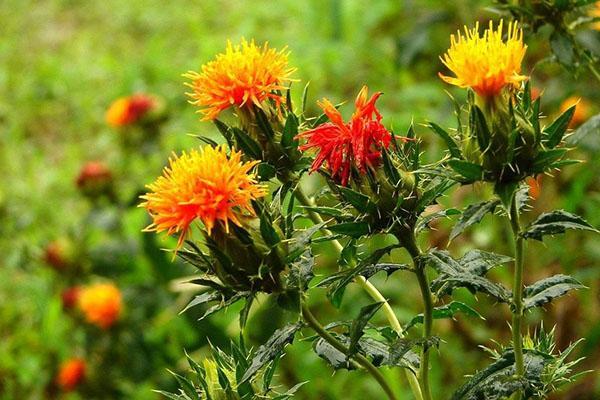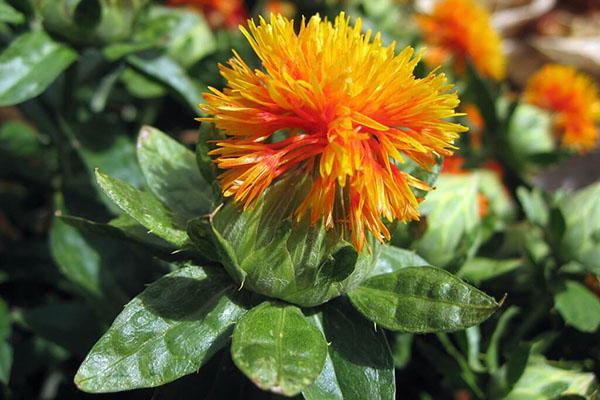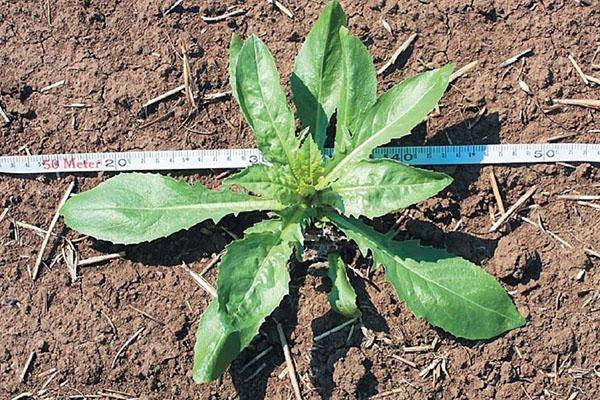Safflower cultivation technology: plant care rules
 The technology of growing safflower is not familiar to many. Most people think that it is necessary to plant and care for this plant in the same way as for most others. In fact, this is not the case. Following certain tips, it will not be difficult to get the desired result.
The technology of growing safflower is not familiar to many. Most people think that it is necessary to plant and care for this plant in the same way as for most others. In fact, this is not the case. Following certain tips, it will not be difficult to get the desired result.
Safflower: a description of the appearance of the culture

Safflower is a good honey plant.
The most popular safflower varieties:
- Steppe;
- Professor Mashanov;
- Solar.
All types of plants have medicinal properties. The stems, leaves and flowers of the culture are used in folk medicine to get rid of many pathologies.
Safflower growing technology
 Since the plant belongs to the group of thermophilic crops, the conditions must be appropriate. This applies not only to the choice of the site, but also to watering and fertilization.
Since the plant belongs to the group of thermophilic crops, the conditions must be appropriate. This applies not only to the choice of the site, but also to watering and fertilization.
Landing place
Sow safflower in areas where it previously grew wheat, rapeseed, oats, flax. It is not recommended to choose beds after sunflowers, carrots, beets or sorghum. In such a place, the flower will develop poorly and will not please with beautiful, abundant flowering. This is due to the fact that such plants are able to draw out a large amount of moisture and useful trace elements from the soil.
In one place safflower can be grown for one season. Re-sowing in the same area should only be done after 4 years.
What should be the soil
 Safflower soil doesn't really matter. The plant grows well on different soils, but most of all the culture prefers chernozems, loams, sub-sandy substrates. Safflower also thrives on saline lands.
Safflower soil doesn't really matter. The plant grows well on different soils, but most of all the culture prefers chernozems, loams, sub-sandy substrates. Safflower also thrives on saline lands.
Before starting sowing, the soil must be plowed. This should be done to a depth of about 20 cm.This will help get rid of many weedsthat can negatively affect the development of the plant.
Seeding time and rate
Planting is carried out together with grain crops. The seeds tolerate low temperatures and freezing well. If the procedure is carried out late, then the moisture in the upper layer of the soil may not be enough for the grains to germinate.
To increase germination, as well as to protect the planting material from insects, you can treat the seeds with the help of the "Premis" or "Cardon.
It is necessary to deepen the grains no more than 8 cm. The distance between the rows should be within 60 cm. 1 hectare will require from 30 to 40 kg of safflower. It all depends on the conditions, soil moisture.
Plant care, pest control and propagation methods
 Adult specimens are not demanding. They do not need to be watered. All this is due to the specific structure of the root system. The center root penetrates deeply into the soil, thus providing the entire crop with the right amount of moisture.
Adult specimens are not demanding. They do not need to be watered. All this is due to the specific structure of the root system. The center root penetrates deeply into the soil, thus providing the entire crop with the right amount of moisture.
The main care is systematic weeding. Safflower needs to loosen the soil and remove weeds.
Plants around which a large amount of weed grows will yield 70% less yield.
As for fertilization, it is not necessary to apply it. If the soil is too poor, then you can feed the plants with organic mixtures. Safflower will also develop well when applied nitrogen-phosphorus preparations.
Potential pests
 Garden plant species most often suffer from insects. Often the flower is affected by the safflower fly, the scoop. Rust and spotting are less common on the leaves. It is quite difficult to get rid of such ailments in order to preserve the plant. Most often, the bushes are removed by the roots and burned. If this is not done, then similar problems can appear on healthy specimens.
Garden plant species most often suffer from insects. Often the flower is affected by the safflower fly, the scoop. Rust and spotting are less common on the leaves. It is quite difficult to get rid of such ailments in order to preserve the plant. Most often, the bushes are removed by the roots and burned. If this is not done, then similar problems can appear on healthy specimens.
Safflower propagation
You can grow a young plant both by seed and seedlings. The first method is the most common and effective. This is due to the fact that the plant does not tolerate transplants well.
Garden species can also be planted using seedlings. For this, the grains are initially sown in peat pots. But despite the fact that safflower will be transplanted with the soil, its growth may still be disrupted.
When is the harvest
 To create beautiful bouquets, plants are cut at the beginning of bud opening. Dry inflorescences are separated much later. The first sign of harvest is a change in color. The inflorescences are suitable when they turn yellowish brown. The grains of the safflower oilseed do not fall off, so you should not be afraid that the seeds will be spoiled. They can crumble only during the collection process, hitting the header blades. The collected seeds are peeled and then dried.
To create beautiful bouquets, plants are cut at the beginning of bud opening. Dry inflorescences are separated much later. The first sign of harvest is a change in color. The inflorescences are suitable when they turn yellowish brown. The grains of the safflower oilseed do not fall off, so you should not be afraid that the seeds will be spoiled. They can crumble only during the collection process, hitting the header blades. The collected seeds are peeled and then dried.
The petals are harvested only after the buds have fully bloomed. In order for the flowers to retain their beauty, it is recommended to dry them as quickly as possible. This is easy enough. Difficulties can arise only with large inflorescences.
Dry safflower with the heads down. Plants are hung up one at a time or in small bunches. This will help prevent mold growth. It is best to carry out the procedure in a room that is well ventilated and has low humidity. Drying plants in direct sunlight is not recommended. Such blanks will retain a small amount of useful vitamins and minerals.
Safflower is not only a beautiful but also a very useful plant. Therefore, in order for the harvesting to bring as much benefit as possible, you should adhere to the rules of care and follow the recommendations for harvesting.